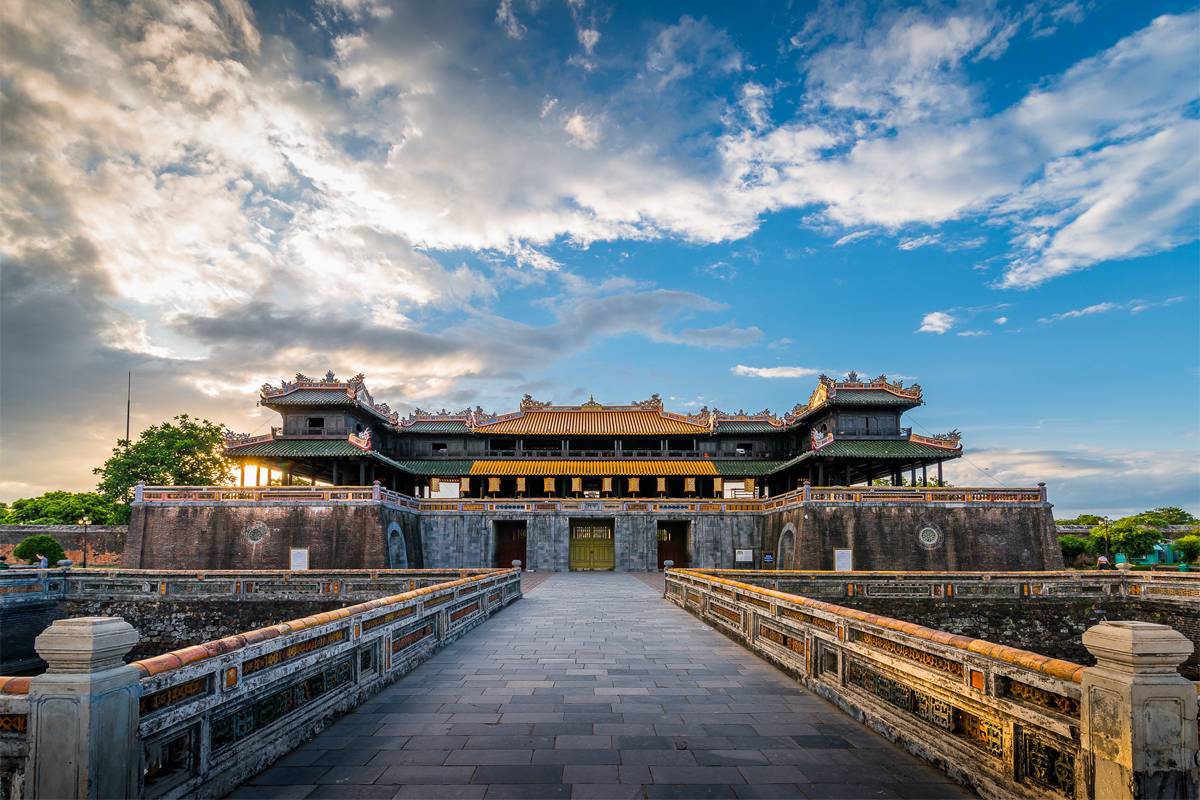Hue, a city rich in culture, history, and charm, is situated in central Vietnam along the banks of the Perfume River (Sông Hương). During the Nguyen Dynasty (1802–1945), Hue served as the imperial capital of Vietnam. As such, it is a wealth of historical buildings, royal ancestry, and cultural customs. One of the most visited locations for travelers wishing to experience Vietnam’s rich history and natural beauty is this UNESCO World Heritage Site.
1. Historical Significance
During the final Vietnamese imperial dynasty, the Nguyen Dynasty, Hue was the capital of Vietnam for about 150 years. During this period, Hue developed into a major religious, cultural, and political hub. The Imperial City, royal tombs, and historic pagodas are just a few of the city’s amazing historical landmarks that capture the splendor of Vietnam’s feudal past.
2. Iconic Attractions
a. Hue Imperial City (Đại Nội)
- Overview: The Imperial City is a massive fortress and palace complex surrounded by a moat and thick walls. It was the political and administrative center of the Nguyen Dynasty.
- Key Highlights:
- Ngo Mon Gate: The main entrance to the Imperial City, featuring impressive architecture.
- Thai Hoa Palace: The ceremonial hall where emperors held important meetings.
- Forbidden Purple City: The private quarters of the royal family (now largely in ruins).
- Temples and Pavilions: Numerous structures dedicated to emperors and ancestors.
- UNESCO Status: Recognized as a World Heritage Site in 1993.
b. Royal Tombs
Hue is famous for its elaborately designed royal tombs, each reflecting the personality and reign of the emperor it commemorates. Must-visit tombs include:
- Tomb of Emperor Minh Mang: Known for its symmetry, serenity, and harmonious design blending nature and architecture.
- Tomb of Emperor Khai Dinh: A unique blend of traditional Vietnamese and European architectural styles, featuring intricate mosaics and grand interiors.
- Tomb of Emperor Tu Duc: A tranquil complex surrounded by pine forests, lakes, and pavilions.
c. Thien Mu Pagoda
- Overview: Perched on a hill overlooking the Perfume River, Thien Mu Pagoda is one of the oldest and most iconic religious sites in Hue.
- Highlights:
- The seven-story Phuoc Duyen Tower, a symbol of Hue.
- A peaceful garden and a historic bell dating back to the 18th century.
- Stunning views of the surrounding countryside and river.
d. Perfume River (Sông Hương)
- Significance: The Perfume River flows gently through Hue, adding to the city’s poetic charm. It gets its name from the fragrant flowers that once fell into the water from nearby orchards.
- Activities:
- Take a dragon boat cruise to enjoy the scenic views and visit riverside attractions.
- Watch the sunset or enjoy traditional music performances on the river in the evening.
e. Dong Ba Market
- Overview: The largest and oldest market in Hue, Dong Ba is a bustling hub where you can experience local life and shop for souvenirs.
- What to Buy: Traditional conical hats, silk products, handicrafts, and local snacks.
f. Hue National School (Quoc Hoc Hue)
- Significance: One of Vietnam’s oldest and most prestigious schools, known for its French colonial architecture and historical importance. It’s also a great spot for photography.
3. Cultural Experiences
a. Hue Traditional Music (Nhã Nhạc)
- UNESCO Recognition: Hue’s Nhã Nhạc (Court Music) is recognized as an Intangible Cultural Heritage of Humanity.
- Experience: Attend a live performance of this classical music, often accompanied by traditional dances, during a boat cruise or at cultural shows.
b. Festivals
- Hue Festival: A biennial event showcasing traditional music, dance, and art performances, as well as reenactments of royal ceremonies.
- Tet Nguyen Dan (Lunar New Year): Celebrate with locals and enjoy traditional rituals and food.
c. Ao Dai Culture
- Hue is known as the birthplace of the Ao Dai, Vietnam’s traditional long dress. Visitors can rent Ao Dai to wear while exploring the city and taking photos.
4. Local Cuisine
Hue is often referred to as the culinary capital of Vietnam, thanks to its royal-inspired cuisine and unique local dishes. Some must-try foods include:
- Bún Bò Huế: A spicy and flavorful beef noodle soup, considered a signature dish of Hue.
- Bánh Bèo: Steamed rice cakes topped with shrimp, pork, and crispy shallots.
- Bánh Khoái: A crispy pancake filled with shrimp, pork, and bean sprouts, served with a peanut dipping sauce.
- Nem Lụi: Grilled pork skewers served with rice paper and fresh herbs.
- Chè Hue: A sweet dessert made from beans, fruits, and coconut milk.
- Cơm Hến (Clam Rice): A humble yet delicious dish made with rice, clams, peanuts, and herbs.
5. Best Time to Visit
- Dry Season (March to August): Ideal for sightseeing, with warm and sunny weather.
- Cool Season (September to November): The weather is cooler, but occasional rains add a romantic atmosphere to the city.
- Festive Season (April or June): If possible, plan your visit during the Hue Festival (held every two years) for an immersive cultural experience.
–>Hue is a city that combines culture, history, and scenic beauty to produce a really remarkable experience. Hue offers a trip into the heart of Vietnam’s legacy, from taking in the splendor of the Imperial City to boating the Perfume River, sampling delectable royal food, and becoming fully immersed in the rich customs of the nation. Hue is a place that will captivate you regardless of your interests—history, cuisine, or culture.


Comment (0)